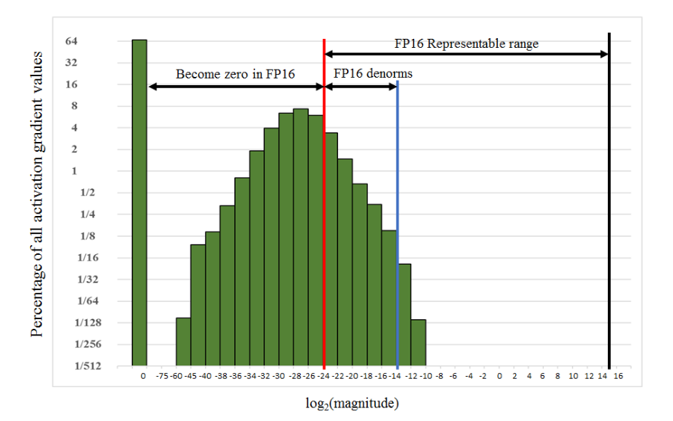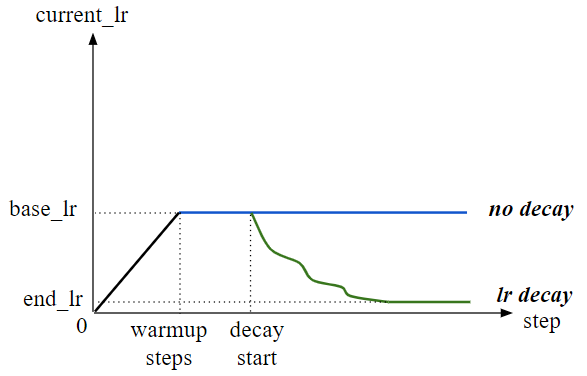HugeCTR Core Features
Summary of Core Features
In addition to single-node and full-precision training, HugeCTR supports a variety of features that are described in the following topics.
NOTE: Multi-node training and mixed precision training can be used simultaneously.
Model Parallel Training
HugeCTR natively supports both model parallel and data parallel training, making it possible to train very large models on GPUs. Features and categories of embeddings can be distributed across multiple GPUs and nodes. For example, if you have two nodes with 8xA100 80GB GPUs, you can train models that are as large as 1TB fully on GPU. By using the embedding training cache, you can train even larger models on the same nodes.
To achieve the best performance on different embeddings, use various embedding layer implementations. Each of these implementations target different practical training cases such as:
LocalizedSlotEmbeddingHash: The features in the same slot (feature field) will be stored in one GPU, which is why it’s referred to as a “localized slot”, and different slots may be stored in different GPUs according to the index number of the slot. LocalizedSlotEmbedding is optimized for instances where each embedding is smaller than the memory size of the GPU. As local reduction for each slot is used in the LocalizedSlotEmbedding with no global reduction between GPUs, the overall data transaction in the LocalizedSlotEmbedding is much less than the DistributedSlotEmbedding.
Note: Make sure that there aren’t any duplicated keys in the input dataset.
DistributedSlotEmbeddingHash: All the features, which are located in different feature fields / slots, are distributed to different GPUs according to the index number of the feature regardless of the slot index number. That means the features in the same slot may be stored in different GPUs, which is why it’s referred to as a “distributed slot”. Since global reduction is required, the DistributedSlotEmbedding was developed for cases where the embeddings are larger than the memory size of the GPU. DistributedSlotEmbedding has much more memory transactions between GPUs.
Note: Make sure that there aren’t any duplicated keys in the input dataset.
LocalizedSlotEmbeddingOneHot: A specialized LocalizedSlotEmbedding that requires a one-hot data input. Each feature field must also be indexed from zero. For example, gender: 0,1; 1,2 wouldn’t be considered correctly indexed.
Multi-Node Training
Multi-node training makes it easy to train an embedding table of arbitrary size. In a multi-node solution, the sparse model, which is referred to as the embedding layer, is distributed across the nodes. Meanwhile, the dense model, such as DNN, is data parallel and contains a copy of the dense model in each GPU (see Fig. 2). With our implementation, HugeCTR leverages NCCL for high speed and scalable inter-node and intra-node communication.
To run with multiple nodes, HugeCTR should be built with OpenMPI. GPUDirect RDMA support is recommended for high performance. For more information, refer to our dcn_2node_8gpu.py file in the samples/dcn directory on GitHub.
Mixed Precision Training
Mixed precision training is supported to help improve and reduce the memory throughput footprint. In this mode, TensorCores are used to boost performance for matrix multiplication-based layers, such as FullyConnectedLayer and InteractionLayer, on Volta, Turing, and Ampere architectures. For the other layers, including embeddings, the data type is changed to FP16 so that both memory bandwidth and capacity are saved. To enable mixed precision mode, specify the mixed_precision option in the configuration file. When mixed_precision is set, the full FP16 pipeline will be triggered. Loss scaling will be applied to avoid the arithmetic underflow (see Fig. 5). Mixed precision training can be enabled using the configuration file.

SGD Optimizer and Learning Rate Scheduling
Learning rate scheduling allows users to configure its hyperparameters, which include the following:
learning_rate: Base learning rate.warmup_steps: Number of initial steps used for warm-up.decay_start: Specifies when the learning rate decay starts.decay_steps: Decay period (in steps).
Fig. 6 illustrates how these hyperparameters interact with the actual learning rate.
For more information, refer to Python Interface.

Embedding Training Cache
Embedding Training Cache (ETC) gives you the ability to train a large model up to terabytes. It’s implemented by loading a subset of an embedding table, which exceeds the aggregated capacity of GPU memory, into the GPU in a coarse-grained, on-demand manner during the training stage.
For more information, see the details for HugeCTR Embedding Training Cache.
HugeCTR to ONNX Converter
The HugeCTR to Open Neural Network Exchange (ONNX) converter (hugectr2onnx) is a Python package that can convert HugeCTR models to ONNX. It can improve the compatibility of HugeCTR with other deep learning frameworks since ONNX serves as an open-source format for AI models.
After training with our HugeCTR Python APIs, you can get the files for dense models, sparse models, and graph configurations, which are required as inputs when using the hugectr2onnx.converter.convert API. Each HugeCTR layer will correspond to one or several ONNX operators, and the trained model weights will be loaded as initializers in the ONNX graph. You can convert both dense and sparse models or only dense models.
For more information, refer to the onnx_converter directory of the HugeCTR repository on GitHub and the hugectr2onnx_demo.ipynb sample notebook.
HDFS Support
HugeCTR supports interactions with HDFS during training, e.g. loading and dumping models and optimizer states from HDFS.
If you use the Merlin NGC container, you can build Hadoop by running the build-hadoop.sh script.
If you want to build HugeCTR from scratch, you should make sure that Hadoop is correctly built in your system and specify -DENABLE_HDFS=ON when you build HugeCTR with cmake.
After HDFS is successfully enabled, you are able to use our Python API to train with HDFS. An end-to-end demo notebook can be found at here.
Hierarchical Parameter Server
HugeCTR Hierarchical Parameter Server (HPS), an industry-leading distributed recommendation inference framework,that combines a high-performance GPU embedding cache with an hierarchical storage architecture, to realize low-latency retrieval ofembeddings for online model inference tasks. Among other things, our HPS features (1) redundant hierarchical storage, (2) a novelGPU-enabled high-bandwidth cache to accelerate parallel embedding lookup, (3) online training support and (4) light-weight APIs forintegration into existing large-scale recommendation workflow.
Try out our hugectr_wdl_prediction.ipynb Notebook. For more information, refer to Distributed Deployment.
For more information about Hierrachical Parameter Server, see the details for HPS Backend and HPS Database Backend.
Sparse Operation Kit
The Sparse Operation Kit (SOK) is a Python package that wraps GPU-accelerated operations that are dedicated for sparse training or inference cases. The package is designed to be compatible with common deep learning frameworks such as TensorFlow.
SOK provides a model-parallelism GPU embedding layer. In sparse training or inference scenarios, such as click-through-rates, there are large number of parameters that do not fit into memory on a single GPU. Common deep learning frameworks do not support model-parallelism (MP). As a result, it is difficult to fully utilize all available GPUs in a cluster to accelerate the whole training process.
For more information, see the Sparse Operation Kit documentation.